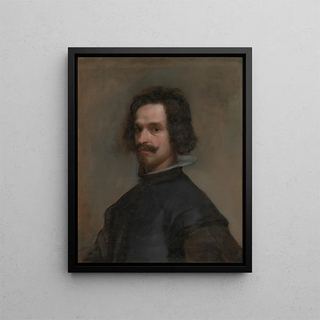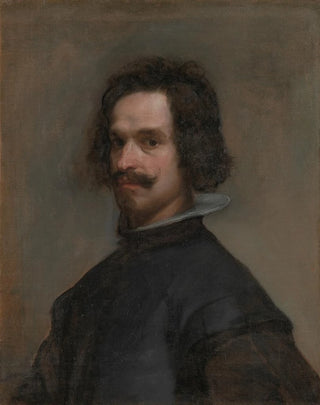Painting Portrait of a man, perhaps a self-portrait - Diego Velázquez | Art print


View from behind

Frame (optional)
Portrait of a Man, Possibly a Self-Portrait - Diego Velázquez – Captivating Introduction
In the landscape of art history, certain works transcend their era to become timeless icons. The "Portrait of a Man, Possibly a Self-Portrait" by Diego Velázquez is one of those creations that captivates the mind and sparks curiosity. This piece, created in the 17th century, embodies not only Velázquez's technical genius but also his ability to capture the complexity of the human soul. The intense gaze of the depicted man seems to transcend a simple portrait, inviting the viewer to deep introspection. In this art print, one perceives the richness of the palette and the finesse of the details, testament to the artist's skill in bringing his subjects to life.
Style and uniqueness of the work
Velázquez's style is distinguished by its realistic approach and masterful use of light. In this portrait, light plays a fundamental role, subtly illuminating the man's face and creating a striking contrast with the dark background. This stylistic choice allows the artist to focus attention on the subject's features, revealing a psychological depth that is a key characteristic of his work. The brushstrokes, both precise and fluid, demonstrate technical mastery that has marked the history of painting. The texture of the skin, the reflections in the eyes, and the delicacy of the clothing are all elements contributing to the uniqueness of this work. Velázquez manages to establish a silent dialogue between the subject and the viewer, making the observation experience deeply immersive.
The artist and his influence
Diego Velázquez, an emblematic figure of Spanish Baroque, knew how to establish himself as one of the greatest masters of painting. Born in 1599 in Seville, he was influenced by the great masters of his time but also developed a style that is uniquely his own. His career was marked by royal commissions, notably that of Philip IV of Spain, which allowed him to create monumental works. Velázquez not only influenced his contemporaries but his legacy endures through the centuries, inspiring artists such as Édouard Manet and Pablo Picasso.

Matte finish

View from behind

Frame (optional)
Portrait of a Man, Possibly a Self-Portrait - Diego Velázquez – Captivating Introduction
In the landscape of art history, certain works transcend their era to become timeless icons. The "Portrait of a Man, Possibly a Self-Portrait" by Diego Velázquez is one of those creations that captivates the mind and sparks curiosity. This piece, created in the 17th century, embodies not only Velázquez's technical genius but also his ability to capture the complexity of the human soul. The intense gaze of the depicted man seems to transcend a simple portrait, inviting the viewer to deep introspection. In this art print, one perceives the richness of the palette and the finesse of the details, testament to the artist's skill in bringing his subjects to life.
Style and uniqueness of the work
Velázquez's style is distinguished by its realistic approach and masterful use of light. In this portrait, light plays a fundamental role, subtly illuminating the man's face and creating a striking contrast with the dark background. This stylistic choice allows the artist to focus attention on the subject's features, revealing a psychological depth that is a key characteristic of his work. The brushstrokes, both precise and fluid, demonstrate technical mastery that has marked the history of painting. The texture of the skin, the reflections in the eyes, and the delicacy of the clothing are all elements contributing to the uniqueness of this work. Velázquez manages to establish a silent dialogue between the subject and the viewer, making the observation experience deeply immersive.
The artist and his influence
Diego Velázquez, an emblematic figure of Spanish Baroque, knew how to establish himself as one of the greatest masters of painting. Born in 1599 in Seville, he was influenced by the great masters of his time but also developed a style that is uniquely his own. His career was marked by royal commissions, notably that of Philip IV of Spain, which allowed him to create monumental works. Velázquez not only influenced his contemporaries but his legacy endures through the centuries, inspiring artists such as Édouard Manet and Pablo Picasso.
12,34 €






